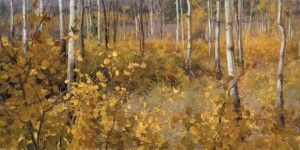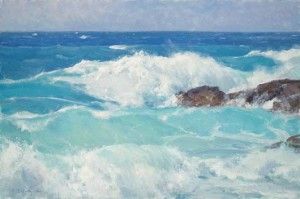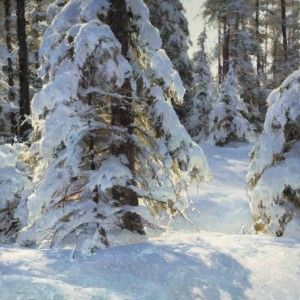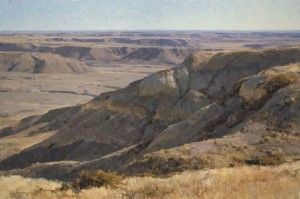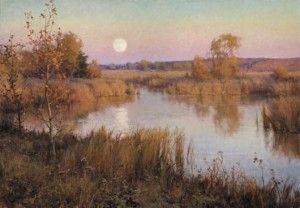I grew up on the prairies of northern Montana, on a farm near a town called Rudyard, a small place that just keeps getting smaller. While I didn’t get any formal art education there, I learned something incredible: how to pay attention. I was a curious and an imaginative kid, and since there wasn’t a lot of easy stimulation out there, I learned that if I wanted to satisfy my curiosity, I had to use my imagination, which meant learning how to take a hard look at things. And that has become a valuable lifelong habit, taking a close look at things and places and vistas, figuring out what makes them interesting, and how to find the beauty in them.
I was lucky to have the parents I had. In a place many people find monotonous, they both had an eye for beauty, an ability to find delight, and a kind of eagerness for it. My father would say, “Look over there. Aren’t the clouds beautiful today?” And he meant it. He wasn’t just trying to distract me. And my mother, until the day she died, was always pointing out the details: flowers, little animals or birds she had seen, the subtle way the seasons progressed.
Both my parents loved to sing, and they liked to pile all the kids in the back seat and drive for hours and hours. Somehow, we never got bored, because they were always singing or pointing out the beauty of things. They showed me that beauty is out there, though it isn’t always obvious. Sometimes you have to know how to look for it.
Living on the prairie, where it seems like you can see forever, also taught me about distance and the mysteries that distance creates: how a perfectly blue sky changes in subtle hues and textures, how shadows change color, depending on how far away they are. The years I spent driving tractors gave me time to study the sky, to learn how clouds move, the language they speak. Spending so much time outside taught me the textures of heat, wind and moisture, the smell of rain, the taste of dust and the blue-green menace of a hail storm coming in.
These experiences from my youth are things that saturate my art today: the association of musical themes with big landscapes, perspective, and paying close attention to nature and being a part of it. These experiences help me solve problems in a painting. Without all that time on a tractor—which I didn’t enjoy much at the time—I don’t think I would relate to the canopy of a sky in quite the same way.
Musicality
Listening to my parents sing while they enjoyed beautiful things and landscapes probably planted seeds in my young brain, helped me sense the connection between music and landscape, but that link really goes back to our roots as humans. My parents just helped to illustrate it. Scientists tell us that music, and maybe dance, are the oldest art forms and possibly the oldest forms of human communication. Music came before language, and it’s a part of us that is very primal. That’s why I try to incorporate musicality into my painting. When you organize a painting in musical terms, you make it easier for people to understand and appreciate because there are rhythms that help them travel through that painting.
The painting INTIMATE ENCOUNTERS provides an example. At a surface level, it’s an aspen grove in the fall. But it’s really all about music. The aspen trunks represent piano keys while the leaves form notes that cascade across the canvas. The brightly colored leaves represent a bolder musical stroke, a key you strike a little harder on a piano, say, and that adds to the visual stimulus. To the viewer, this painting might evoke jazz, or even Bach, but however you listen to it, the musicality of the work dominates. It asks your ears to give a hand to your eyes and your brain.
AQUA MUSIC is another example of musical themes in painting. You get the swirling rhythms in the foam, where I used heavy brush strokes to enhance a sense of movement, while the repetitive shapes of the foam lines throughout the painting create an overall harmony. I love the smooth sensuousness of this piece, then the contrast of the unexpected intrusion of the rocks on the right. As with good music, the wave creates a sense of anticipation: you want to know how far it’s going to go. Follow the curve of the upper wave from the left to the right. Notice how it begins with a thin line that bursts into the explosion of the wave and then loops back into a fading note, there beyond the rock. It might help to think of it as a passage that Miles Davis is playing on his horn. You want to know where he’s going to take you. I love to think about these things as I design a piece.
Brain Work
The painting WINTER GLOW employs music along with several other ideas working together, all aiming to transcend the ordinary, to give the viewer a new experience that arises from a familiar subject. We’ve known for a long time that our brains respond to new stimulus by releasing chemicals that give us pleasure. We can all get bored with constant familiarity, so if the artist wants to give the viewer a new experience, it helps to change the schema of things. Start with the foreground shadow in WINTER GLOW. Out in nature, a shadow in that type of light would seem to be just a mass of dark blue. In this shadow, I’ve included a variety of colors, shapes and textures, something the eye might not catch at first glance because we tend to think of shadows as monochromatic.
What I’m doing here is setting you up for something new and surprising: the complexities a shadow can reveal. That’s a pleasing discovery for the viewer. Then I’m asking you to move through the painting. The shapes provide a resonant music. In the branches of the central tree, you can see musical scales, bass notes on the shady side, where the viewer stands, but more sprightly where the light in the background comes in nice and strong. You’re looking into that light, feeling the invitation, hearing the tinkle of a higher key. I want you to walk through this scene, go over to the sunny side of that tree and be blasted by light, by warmth, to stand where the music becomes a brighter song. I want you, as the viewer, to travel through the painting and feel that. Colors help your eye make that journey, from the cold blue shadows to the golden warmth.
Scraping Down
At some level, a painting is just a pile of paint. Early in my career, I thought that if I copied every detail in the landscape it would seem more real. I suppose it was good practice, because it helped hone the practice of looking very closely at things. But I grew frustrated with it and began scraping down my canvas, and I realized that simple shapes or silhouettes were more powerful and seemed more realistic. I didn’t need to paint every blade of grass to create the illusion of grass. If you look closely at my paintings, you don’t see grass or trees or earth, but abstractions of those items, something the viewer’s eye and mind recognize as grass or trees or earth. So it’s a realistic scene, but it’s created through all sorts of abstract images. I realize that’s a fine line, but look closely and I think you’ll see it.
In the painting CREEPING JUNIPER, look at the grass in the foreground. Look closely, and you’ll see that it’s a painted symbol of grass. You don’t see any individual stems. The symbol of grass helps the mind create the image. Your mind fills in the details, and that’s what makes the painting work. It’s full of abstractions that combine to create something that resonates.
By subordinating details, creating abstractions, employing unusual compositions or techniques, we can create more knowledge gaps. These little questions or mysteries pull the viewer into further analysis, and the artist encourages this quest. The more sophisticated the approach, the more intriguing the work of art becomes. The MONA LISA invites participation not only because of the smile but because of how the figure is presented against such a mysterious background. Mystery is a vital part of a landscape painting because it invites the viewer to stick around and explore, to fill in those knowledge gaps.
Going Outside
To create a realistic illusion of nature, you’ve got to understand nature and the way to do that is to spend time paying attention to it. You’ve got to combine all your senses, the way I learned to do when I was a kid. You’ll paint a better seascape if you’ve felt the spray and know the sound of the surf, how it starts with a whoosh, then becomes a roar that fades to a whisper. And you’ll paint a better rainstorm if you know that when raindrops hit the face of a warm cliff they have a very different smell than when they hit a forest floor. And you can’t know those things if you keep both feet indoors all the time. You have to go out in the natural world, and you have to use that as your basic source. There’s really no way around that.
I want to encourage people to spend more time outside and to appreciate the importance of nature. I want them to see the beauty, but also to feel more connected. An artist’s job is to create a piece that changes a person’s normal perceptions of something, to try to get you to think about things in a different way, to start looking at them as having more content, more meaning, more relevance to other things in life.
That’s where I’m aiming in the painting MOONRISE OVER BOONE CREEK. Obviously, I’m exploring the aesthetic beauty of the moonrise, bathed in warm light by the setting sun, which is very much a part of the painting, though its presence is implied and not stated. The moon and sun have always been metaphors for our understanding of the cosmos, which is far from complete. The warm and cool contrasts of color represent the cycles we experience throughout life. The foreground shadows are full of intertwining tangles of grasses and weeds, which is where you find microbes, bacteria, insects and frogs, which are essential to the biodiversity of this little ecosystem, which is part of the greater universe that stretches to infinity. It’s all connected.
When I was a kid on a farm fifty years ago, nature provided everything. We used machinery, of course, but our livelihood resulted from the combination of soil and water and sunlight and chlorophyll, to which we added our own sweat. These days, we too often see nature as a power that can harm us, in disastrous ways, like a hurricane, or in merely annoying ways, like mosquito bites. In reality, a better understanding of how the natural world works and how we can learn from it is what will sustain us. I hope that by showing the aesthetic side of nature, even in what many people consider to be harsh places, I can move people to be more active as good stewards of our world.
I’m concerned about the future, but I remain optimistic. That’s why I get involved in projects to protect nature and to reconnect people to it. I work with the American Prairie Foundation, which is restoring wildlife and natural processes to three million acres of native prairie in Montana. And I’m putting together an internet program called “Land Snorkeling.” That name sounds like an oxymoron, but it’s really just an effort to get people—especially children—to go outside and pay attention, to move slowly and to look closely, as if they were snorkeling over a coral reef where everything is new and beautiful and interesting. I think almost every part of nature can be just as compelling if you open your mind to it. Land Snorkeling isn’t about physical exertion, though it always feels good to stretch your legs. Rather, it’s about exercising your imagination.
I want to use my skills as an artist to awaken our senses to the beauty that surrounds us every day, to seek it out with a little vigor, like my father, who always kept an eye open for the beautiful and the unusual, even in a familiar place. Life is an incredible journey of curiosity, imagination and awe. Beauty stands all around us if we just build the habit of looking for it. That’s what I want to help people do.
Dossier
Representation
www.clydeaspevig.com
Upcoming Show
American Grandeur, one-man exhibition, Santa Barbara Historical Museum, Santa Barbara, CA, through January 31.
New Book
Visual Music: The Landscapes of Clyde Aspevig is available this month.
Featured in November 2010






